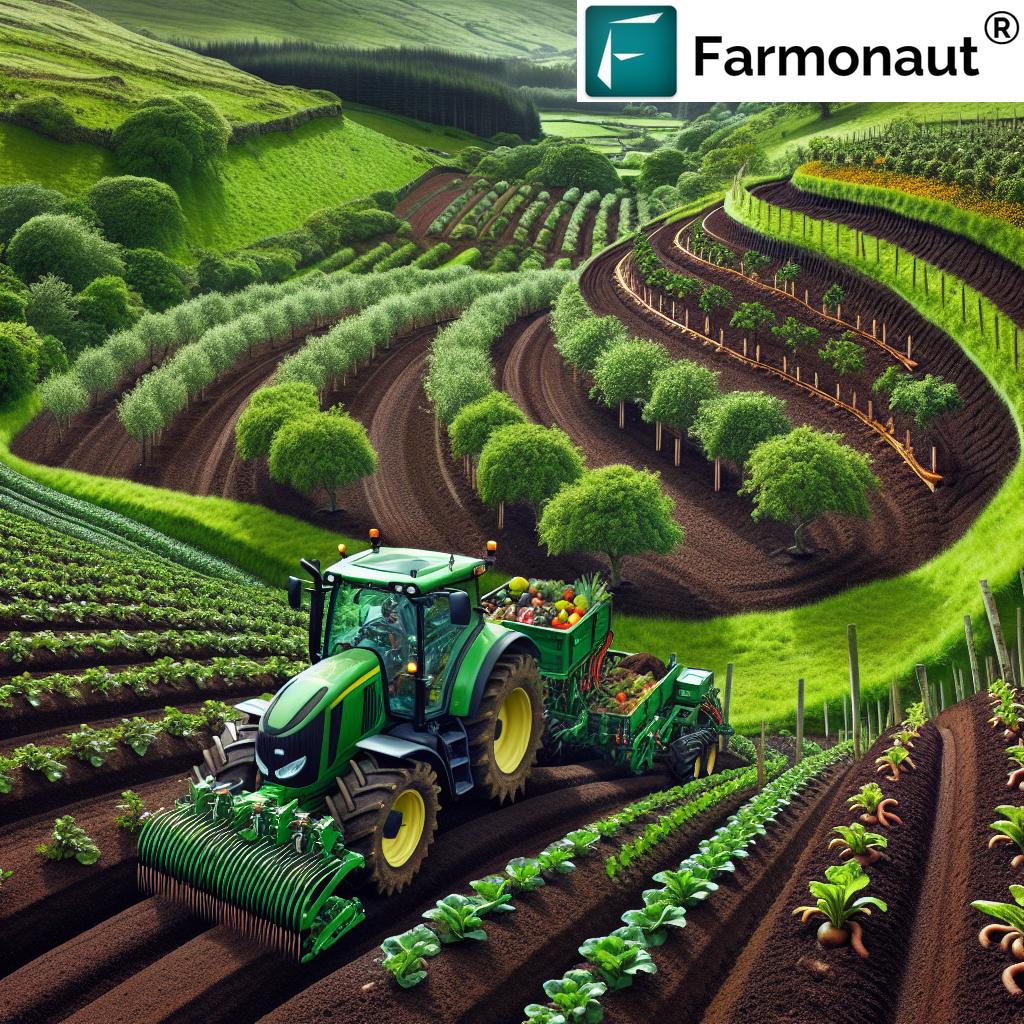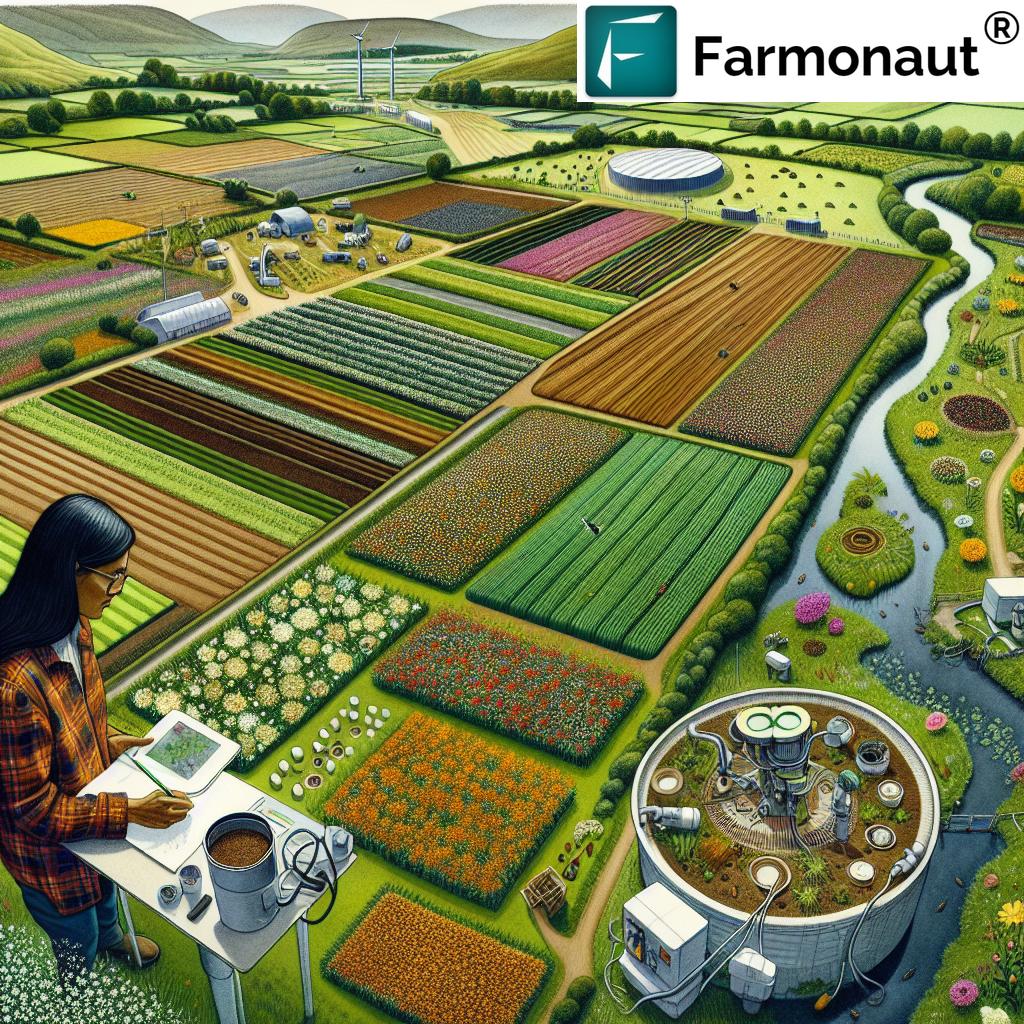Unlocking Sustainable Agriculture: 10 Organic Farming Techniques to Boost Soil Health in Scotland’s Crops

“Implementing cover crops can reduce soil erosion by up to 90% while improving nutrient retention in Scottish farmlands.“
Welcome to our comprehensive guide on unlocking sustainable agriculture through organic farming techniques that boost soil health in Scotland’s crops. As we delve into this crucial topic, we’ll explore ten powerful methods that can transform the way we approach farming in the beautiful Scottish landscape. Our focus is on enhancing soil health, a cornerstone of sustainable and regenerative agriculture practices.
In Scotland, where the agricultural heritage is as rich as the soil itself, we’re witnessing a shift towards more sustainable farming methods. This transition is not just about preserving our environment; it’s about ensuring the long-term viability of our farms and the quality of our food. By adopting organic farming techniques, we can reduce agricultural pollution, improve crop yields, and contribute to a healthier ecosystem.
The Importance of Soil Health in Scottish Agriculture
Before we dive into the specific techniques, let’s understand why soil health is so crucial for Scotland’s agricultural landscape:
- Nutrient Cycling: Healthy soils are better at retaining and cycling nutrients, reducing the need for synthetic fertilisers.
- Water Management: Well-structured soils improve water retention and drainage, crucial in Scotland’s varied climate.
- Carbon Sequestration: Healthy soils act as a carbon sink, helping to mitigate climate change effects.
- Biodiversity Support: A thriving soil ecosystem supports a wider range of plants and animals above ground.
Now, let’s explore the ten organic farming techniques that can revolutionize soil health in Scotland’s crops.
1. Cover Crop Selection: Nature’s Soil Protectors
Cover crops are the unsung heroes of sustainable agriculture. In Scotland, where winters can be harsh, and soil erosion is a concern, choosing the right cover crops can make a significant difference. These plants protect the soil during off-seasons and contribute to its health in numerous ways.
- Erosion Control: Cover crops like winter rye or clover form a protective blanket over the soil, reducing wind and water erosion.
- Nutrient Enhancement: Leguminous cover crops, such as field beans or vetch, fix nitrogen in the soil, reducing the need for synthetic fertilizers.
- Soil Structure Improvement: Deep-rooted cover crops like radishes can break up compacted soil layers, improving aeration and water infiltration.
Implementing cover crops in your rotation can lead to significant improvements in soil health. For instance, a study in the Scottish Highlands showed that fields with winter cover crops had 30% higher organic matter content compared to bare fields after just three years.
2. Natural Pest Control: Harnessing Biodiversity
Moving away from synthetic pesticides is a crucial step in organic farming. In Scotland, we can leverage the power of biodiversity to manage pests naturally. This approach not only protects crops but also enhances the overall health of the farm ecosystem.
- Companion Planting: Grow pest-repelling plants like marigolds or nasturtiums alongside your main crops.
- Beneficial Insects: Encourage ladybirds, lacewings, and hoverflies by planting diverse flower strips.
- Crop Rotation: Disrupt pest life cycles by changing crop locations each season.
By adopting these natural pest control methods, Scottish farmers can reduce their reliance on harmful chemicals, preserving soil health and biodiversity. For example, a farm in Perthshire reported a 50% reduction in aphid infestations after implementing companion planting techniques.
3. Crop Rotation Strategies: The Soil’s Rejuvenation Cycle
Crop rotation is a fundamental practice in organic farming that plays a crucial role in maintaining soil health. In Scotland, where the growing season can be shorter, strategic crop rotation becomes even more important.
- Nutrient Management: Alternate between heavy feeders (like brassicas) and soil builders (like legumes).
- Pest and Disease Control: Break cycles of pest infestation and soil-borne diseases.
- Soil Structure Improvement: Vary crops with different root structures to enhance soil quality at various depths.
A well-planned crop rotation can lead to significant improvements in soil health and crop yields. For instance, a long-term study in the Scottish Borders showed that fields under a four-year rotation cycle had 25% higher organic matter content compared to fields with continuous cropping.
4. Agroforestry: Integrating Trees for Soil Health
“Agroforestry systems can increase farm productivity by 40-200% compared to conventional monoculture practices in Scotland’s agricultural landscape.“
Agroforestry is an innovative approach that combines trees and shrubs with crop or livestock systems. In Scotland, where traditional forestry and agriculture have long histories, agroforestry offers a bridge between these practices, providing numerous benefits for soil health.
- Wind Protection: Trees act as windbreaks, reducing soil erosion and protecting crops.
- Nutrient Cycling: Deep tree roots bring up nutrients from lower soil layers, benefiting nearby crops.
- Carbon Sequestration: Trees significantly increase the carbon storage capacity of agricultural land.
- Biodiversity Enhancement: Agroforestry systems create diverse habitats, supporting a wide range of wildlife.
The benefits of agroforestry extend beyond soil health. For example, a mixed agroforestry system in Aberdeenshire reported a 30% increase in overall farm productivity compared to conventional monoculture farming.
5. Organic Matter Management: Feeding the Soil
The heart of soil health lies in its organic matter content. In Scotland’s diverse agricultural regions, from the fertile lowlands to the challenging highlands, managing organic matter is crucial for maintaining and improving soil quality.
- Compost Application: Regularly add well-decomposed compost to enrich the soil.
- Green Manures: Incorporate nitrogen-fixing plants like clover or alfalfa into your rotation.
- Crop Residue Management: Leave crop residues on the field to decompose and return nutrients to the soil.
Consistent organic matter management can lead to remarkable improvements in soil health. A long-term study in Fife showed that fields receiving regular compost applications had 40% higher water-holding capacity and 25% more earthworms compared to conventionally managed fields.

6. Low-Till Cultivation: Preserving Soil Structure
Transitioning to low-till or no-till farming practices is a significant step towards sustainable agriculture. In Scotland, where soil erosion can be a concern, especially in hilly areas, these techniques are particularly valuable.
- Minimal Soil Disturbance: Reduce ploughing and tilling to preserve soil structure and beneficial organisms.
- Improved Water Retention: Undisturbed soil retains more moisture, crucial in drier regions of Scotland.
- Enhanced Carbon Sequestration: Less soil disturbance means more carbon stays locked in the soil.
The adoption of low-till practices can lead to significant improvements in soil health. For instance, a farm in the Scottish Borders reported a 20% increase in earthworm populations and a 15% improvement in water infiltration rates after switching to low-till methods.
7. Precision Irrigation: Water Management for Soil Health
While Scotland is known for its ample rainfall, efficient water management remains crucial for soil health, especially in the face of changing climate patterns. Precision irrigation techniques can help maintain optimal soil moisture levels without causing erosion or nutrient leaching.
- Drip Irrigation: Deliver water directly to plant roots, reducing water waste and soil disturbance.
- Soil Moisture Monitoring: Use sensors to accurately determine when irrigation is needed.
- Rainwater Harvesting: Collect and store rainwater for use during drier periods.
Implementing precision irrigation can lead to significant water savings and improved soil health. A vegetable farm in East Lothian reported a 30% reduction in water usage and a 20% increase in crop yield after implementing a drip irrigation system guided by soil moisture sensors.
8. Biological Soil Amendments: Boosting Soil Life
Enhancing the biological activity in soil is a key aspect of organic farming. In Scotland’s diverse agricultural landscapes, from the rich lowlands to the challenging highlands, biological soil amendments can play a crucial role in improving soil health and crop productivity.
- Mycorrhizal Fungi: These beneficial fungi form symbiotic relationships with plant roots, enhancing nutrient uptake.
- Compost Tea: A liquid extract of compost that’s rich in beneficial microorganisms.
- Biochar: A form of charcoal that improves soil structure and supports microbial life.
The use of biological amendments can lead to significant improvements in soil health and crop yields. For example, a raspberry farm in Angus reported a 25% increase in fruit yield and improved disease resistance after incorporating mycorrhizal fungi into their soil management practices.
9. Hedgerow Management: Creating Biodiversity Corridors
Hedgerows are a traditional feature of the Scottish agricultural landscape, and their proper management can significantly contribute to soil health and overall farm biodiversity.
- Wind Protection: Well-maintained hedgerows act as windbreaks, reducing soil erosion.
- Habitat Creation: Hedgerows provide homes for beneficial insects and wildlife.
- Nutrient Cycling: Leaf litter from hedgerows contributes organic matter to nearby soil.
The benefits of proper hedgerow management extend beyond the immediate vicinity. A study in the Scottish Highlands showed that farms with well-maintained hedgerows had 40% higher populations of pollinating insects compared to those without, leading to improved crop pollination and yields.
10. Integrated Livestock Management: Synergizing Crops and Animals
Integrating livestock into crop systems can create a synergistic effect that enhances soil health. This practice, often referred to as mixed farming, has deep roots in Scottish agricultural tradition and is experiencing a revival in organic farming circles.
- Natural Fertilization: Grazing animals provide manure, enriching the soil with organic matter and nutrients.
- Crop Residue Management: Livestock can graze on crop residues, aiding in their breakdown and incorporation into the soil.
- Soil Structure Improvement: Controlled grazing can help break up compacted soil layers.
The integration of livestock can lead to significant improvements in soil health and farm productivity. A mixed farm in Dumfriesshire reported a 30% increase in soil organic matter and a 20% reduction in feed costs after implementing a rotational grazing system with their crop production.
Leveraging Technology in Organic Farming
While organic farming focuses on natural processes, modern technology can play a crucial role in optimizing these practices. At Farmonaut, we offer innovative solutions to help farmers implement and monitor sustainable agriculture practices effectively.
- Satellite-Based Crop Monitoring: Our advanced satellite imagery technology allows farmers to track crop health, soil moisture levels, and vegetation indices in real-time. This data helps in making informed decisions about irrigation, fertilization, and pest management.
- AI-Powered Advisory System: Our Jeevn AI system provides personalized recommendations based on real-time farm data, helping farmers optimize their organic practices for maximum soil health and crop yield.
- Resource Management Tools: Our platform offers tools for efficient management of farm resources, ensuring that organic practices are implemented in the most sustainable and cost-effective manner.
By integrating these technological solutions with organic farming techniques, Scottish farmers can achieve higher precision in their sustainable agriculture practices, leading to healthier soils and more robust crops.
Explore our solutions:
For developers interested in integrating our technology into their own systems, check out our API and API Developer Docs.
Comparative Analysis of Organic Farming Techniques
| Technique | Soil Health Benefits | Crop Yield Impact | Implementation Difficulty |
|---|---|---|---|
| Cover Crop Selection | High | Medium | Moderate |
| Natural Pest Control | Medium | Medium | Challenging |
| Crop Rotation Strategies | High | High | Moderate |
| Agroforestry | High | High | Challenging |
| Organic Matter Management | High | Medium | Easy |
| Low-Till Cultivation | High | Medium | Moderate |
| Precision Irrigation | Medium | High | Challenging |
| Biological Soil Amendments | High | Medium | Easy |
| Hedgerow Management | Medium | Low | Easy |
| Integrated Livestock Management | High | High | Challenging |
The Future of Organic Farming in Scotland
As we look to the future of agriculture in Scotland, the adoption of these organic farming techniques presents a promising path towards sustainability and improved soil health. The combination of traditional wisdom and modern technology offers Scottish farmers powerful tools to enhance their land’s productivity while preserving its ecological integrity.
The journey towards fully sustainable agriculture is ongoing, and each farm’s approach will be unique. However, by implementing these organic farming techniques and leveraging advanced technologies like those offered by Farmonaut, Scottish farmers can play a crucial role in building a more resilient and sustainable food system.
Frequently Asked Questions
- Q: How long does it take to see improvements in soil health after implementing these organic techniques?
A: While some benefits can be observed within the first growing season, significant improvements in soil health typically take 3-5 years of consistent organic management. - Q: Are organic farming techniques economically viable for small-scale farmers in Scotland?
A: Yes, many organic techniques can be cost-effective for small-scale farmers, especially when combined with proper planning and technology like Farmonaut’s solutions to optimize resource use. - Q: How can Farmonaut’s technology assist in implementing these organic farming techniques?
A: Farmonaut’s satellite-based monitoring and AI advisory systems can help farmers track soil health, optimize resource use, and make data-driven decisions in implementing organic practices. - Q: What are the main challenges in transitioning to organic farming in Scotland?
A: Common challenges include the initial learning curve, potential yield reductions during the transition period, and adapting to Scotland’s specific climate and soil conditions. - Q: How does organic farming contribute to climate change mitigation in Scotland?
A: Organic farming practices, especially those focusing on soil health, can significantly increase carbon sequestration in soil, reducing greenhouse gas emissions from agriculture.
Conclusion
Adopting organic farming techniques to boost soil health in Scotland’s crops is not just a trend, but a necessary step towards a sustainable agricultural future. By implementing these methods, Scottish farmers can improve their soil health, increase biodiversity, reduce environmental impact, and potentially increase their long-term productivity.
Remember, the journey to sustainable agriculture is ongoing, and every small step counts. Whether you’re a seasoned organic farmer or just starting to explore these methods, there’s always room for improvement and innovation.
At Farmonaut, we’re committed to supporting farmers in this transition with our cutting-edge technology and data-driven insights. Together, we can cultivate a healthier, more sustainable future for Scotland’s agriculture.
Start your journey towards sustainable farming today. Explore our solutions and see how Farmonaut can help you implement these organic farming techniques effectively.






